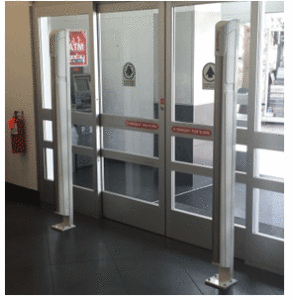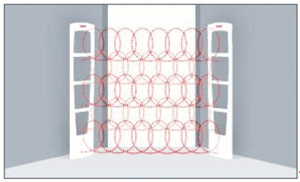Have you ever noticed the different bottles that beverage makers use to sell their products, especially the wine and alcohol manufacturers? Bottle shapes, sizes, and styles along with the labels and packaging are meant to provide a distinction from competitors to make their brand stand out. Sometimes, as with boxed wines, the idea is to promote the packaging as more environmentally friendly that those in glass bottles. Use a gold foil around the top of the champagne bottle and the message you may be sending your customers is that this is a brand the sophisticated and wealthy consumer is drinking. The messaging being sent by the manufacturer of a product is usually the result of testing to marketing groups. So when I begin to think about writing about the value of bottle locks to prevent theft, I have to take into consideration, what impact if any, the device might have on the selling features of the beverages.
My first priority when writing is to help retailers find the best liquor bottle security device on the market to help them prevent shortage due to theft and in some cases, even unintentional walk outs. Using bottle locks is the optimum solution for prevention of theft because they operate with electronic article surveillance (EAS) systems. Install an EAS system and when a bottle with a bottle lock is carried within the range of an EAS antenna, the antenna sounds a loud alarm and built in lights flash, alerting store personnel to a situation that needs attention. Using bottle security also deters theft since shoplifters don’t want to hassle with trying to force off a security device or risk setting off an alarm when they walk out a door. If a cashier forgets to check the bottom of a shopping cart and a bottle has been overlooked, the alarm will sound and the patron can return and pay for it.
Obviously then, bottle security is a great solution to preventing shortage, but you may still be concerned that you don’t want to cover up the labeling information or detract from the packaging of your bottles. Alpha Security has produced a Crystal Guard security device that covers the bottle cap and part of the neck of the bottle. It has a clear front that provides the customer the ability to view the label and wrapping around the top of the bottle. The device still covers up plenty of the bottle cap, making it nearly impossible to tamper with the cap or the device itself. The features of the bottle labeling are not interfered with and thus keep the allure of that particular selling point.
If, on the other hand, you are strictly concerned with liquor bottle security and preventing theft and the package labeling is secondary you may be interested in the Alpha Security S3 Bottle Cap. This liquor bottle security lock is, in my opinion, simply no-nonsense in appearance. It doesn’t look like it’s supposed to be pretty or classy; for a security device if it could talk it would say, “Don’t mess with me”. Just the visual impact of these bottle locks would send the message to shoplifters to go away. This Alpha Security device covers the entire lid and top portion of a bottle and is extremely difficult to tamper with. As a matter of fact tampering with this or any of the bottle locks could result in a broken bottle. There is no clear or see through functionality on this lock so bottle neck labels or foils will not be seen, but that may not be a concern if it keeps the merchandise in the store.
Trying to maintain the balance of selling features with the need to prevent theft and shortage can be tricky. Alpha Security has a broad selection of bottle locks that can meet your needs for bottle security and showing off the eye catching features of your merchandise.
Need information on bottle locks? Contact us or give us a call at 1.770.426.0547 now.

 For decades the gold standard of learning theory was that people needed to be told something 3 times before they really understood and remembered it. If you wanted people to learn something you were supposed to: tell them what you’re going to tell them, then tell them, then tell them what you just told them.
For decades the gold standard of learning theory was that people needed to be told something 3 times before they really understood and remembered it. If you wanted people to learn something you were supposed to: tell them what you’re going to tell them, then tell them, then tell them what you just told them.
 According to the
According to the 
 Is your burglar alarm giving you all it’s got? Technology keeps updating but there is one area you may not be thinking about getting more from your dollar: your burglar alarm system.
Is your burglar alarm giving you all it’s got? Technology keeps updating but there is one area you may not be thinking about getting more from your dollar: your burglar alarm system. My grandparents owned a small hardware store back in the late 1950s. Back then, when my grandpa left at 5pm, he simply locked the back door, gathered his belongings and left, locking the double glass front door behind him with nothing more than a standard lock that you’d find on any home at the time. The front of the store was nothing but glass. He had cash and at least $100k worth of merchandise on the shelves. Wouldn’t it be nice if things could go back to the way they were back then? Could you imagine if you left your store this soft nowadays? Burglaries happen, and they happen often. Over the past ten years as a Regional LP manager for my company, I’ve had it happen a total of 12 times. About once a year, or so, someone, somewhere across my region, breaks into one of my stores; or at least tries to do so. We have a lot of things that we implement to prevent this from happening, so when someone is able to breach our perimeter, it’s usually caused by human error.
My grandparents owned a small hardware store back in the late 1950s. Back then, when my grandpa left at 5pm, he simply locked the back door, gathered his belongings and left, locking the double glass front door behind him with nothing more than a standard lock that you’d find on any home at the time. The front of the store was nothing but glass. He had cash and at least $100k worth of merchandise on the shelves. Wouldn’t it be nice if things could go back to the way they were back then? Could you imagine if you left your store this soft nowadays? Burglaries happen, and they happen often. Over the past ten years as a Regional LP manager for my company, I’ve had it happen a total of 12 times. About once a year, or so, someone, somewhere across my region, breaks into one of my stores; or at least tries to do so. We have a lot of things that we implement to prevent this from happening, so when someone is able to breach our perimeter, it’s usually caused by human error. It was 4:30am on a Tuesday morning. My company cell phone pierced through the quiet halls of my house. At first, I didn’t get out of bed; perhaps it was a wrong number. Silence. As I doze back off, I hear the familiar tone once again. Who could be calling me and for what reason at this hour? I let it ring. I hear the chirp of the voicemail. Before I can muster the energy to get out of bed, I hear my personal phone ringing. This one is next to me on the night stand. Something is wrong, I immediately think to myself. When I reach for my phone in the middle of the dark room, eyes still blurry, I see the caller ID. It’s a sheriff’s deputy that I’m good friends with. My heart is in my throat as I answer. “You’re morning crew was just robbed at gunpoint. Get to the store now.”
It was 4:30am on a Tuesday morning. My company cell phone pierced through the quiet halls of my house. At first, I didn’t get out of bed; perhaps it was a wrong number. Silence. As I doze back off, I hear the familiar tone once again. Who could be calling me and for what reason at this hour? I let it ring. I hear the chirp of the voicemail. Before I can muster the energy to get out of bed, I hear my personal phone ringing. This one is next to me on the night stand. Something is wrong, I immediately think to myself. When I reach for my phone in the middle of the dark room, eyes still blurry, I see the caller ID. It’s a sheriff’s deputy that I’m good friends with. My heart is in my throat as I answer. “You’re morning crew was just robbed at gunpoint. Get to the store now.”